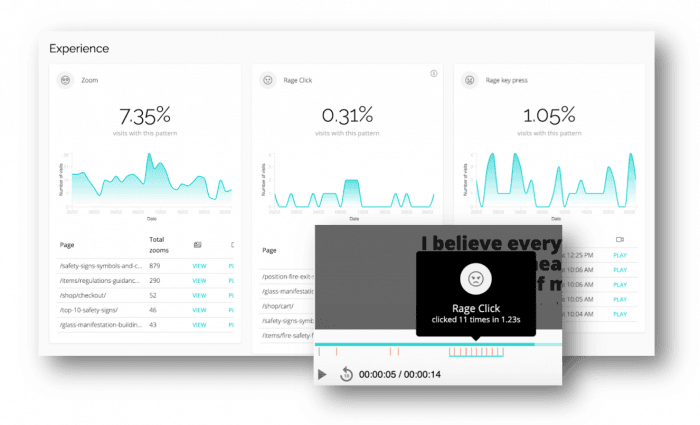October 27, 2025
5 min read
Discover real insights beyond session replay: 4 reasons to switch
A while ago, we came across the article “X Reasons Why You Need Session Replay Tools”. And we have only one thing to say: bull!

Updated October 2025
Traditional session replays waste valuable time, miss crucial context by focusing on sessions instead of full visits, invite cognitive bias, and lack the automation needed for efficient user behavior analysis; focus instead on automated insights from complete user journeys.
4 reasons why you don't need Session Replay Tools
1. You lack time for manual video analysis
Let’s face it: no one has time to watch hundreds of thousands of videos of their users’ visits in user session replay tools! It’s not a gripping thriller, but a tedious – quite often dry as dust – duty that hinders user behavior analysis. The research shows that entrepreneurs can dedicate – with favorable conditions – about 5% of their time to the entire analytical process. And you want to tell me that someone will spend their 5% on binge-watching session replay of this one customer who was not able to get through to the checkout on their own? My eye!
2. Sessions are not worth a cracker
If I’ve told you once, I’ve told you a thousand times: visits are a much more reliable analytical value than sessions! How come? The difference between a visit and a session (if we take into account web analytics) is enormous.
A session is only a fragment of the user’s entire visit to the site. If we want our user behavior analysis (UBA) to be complete and accurate, we need to take account of the whole visit. It may consist of many tabs (and each of these tabs will be a separate session) that the customer opens to compare the products or services we offer.

Imagine that the user opens 7 tabs and then makes a final purchase. If you’ll be analyzing sessions – like most of the analytical tools do – you’ll be analyzing each tab separately. This may lead you to wrongly conclude that there are not one, but seven users, of whom only one made a purchase and the rest left our site without converting. Whilst analyzing all the tabs as components of one visit, you’ll have a full picture of what is happening on the site.
You’ll see that this was only one customer who opened seven tabs just to compare products before making a purchase. The conversion for this analysis will be 100% (one customer = one finalization of the transaction). Since this is the best possible conversion rate, you don’t have to think about additional expenses for advertising campaigns or changes on the website.
3. Cognitive biases are inevitable
Until now, working with data in any organization very often consisted of randomly checking statistics, viewing occasionally selected sessions recordings, and seeking support for your hypotheses. Possibly downloading ready-made reports for presentation to the boss at the end of the month. Of course, this has nothing to do with being data-driven!
Data collection is only 1/3 of the success. You need to be able to combine information to check if hypotheses are correct and to deepen them. To do this, while avoiding cognitive biases, you must create an articulate and comprehensive analytical strategy of the company.
The session replay tools provide crude figures, not conclusions. So it’s up to you to make sense of the numbers and translate them into business recommendations. And this is a truly friendly environment for most cognitive biases to appear.
The most common cognitive biases in analytics are:
- IKEA EFFECT – overestimating the things we have done ourselves,
- STREET LIGHT EFFECT – searching for information in places known, easy and accessible,
- CONFIRMATION BIAS – looking for information that confirms our initial hypotheses,
- SELECTIVE PERCEPTION – how we interpret data largely depends on our expectations.
4. Automation delivers faster and more reliable results
If you can measure something, you can optimize it! So why waste time (and often nerves – you won’t fool us) on single-handed and tedious data analysis when you can use tools that will do it for you?
CUX is the first and only digital experience analytics platform in the world. This means that it will recognize, detect and define the behavioral patterns of your users by itself. Then the tool will show you how those experiences influence UX regarding your business goals. As a result, you’ll get hard-to-understand emotions converted into easily approachable metrics.

How CUX automates deeper user behavior analysis
- CUX automatically selects relevant recordings and heatmaps based on your goals, streamlining the process to see website visitors' critical moments. You don’t have to watch all the recordings anymore!
- CUX will track user frustrations and alert you when they reach a disturbing level. You don’t have to keep an eye on your data!
- CUX will prepare quick segments for you that you can use to filter your data. You can also create your filters and save them into segments – so you will be able to come back to them at any time.
- CUX works retroactively, which means you can return to your data at any time and perform user behavior analysis even on historical data.
- CUX autocaptures events on your site. You don’t have to code each of them separately!
Drop a line and meet with our consultants. We will discuss how to make you benefit from user behavior analysis beyond session replays.
